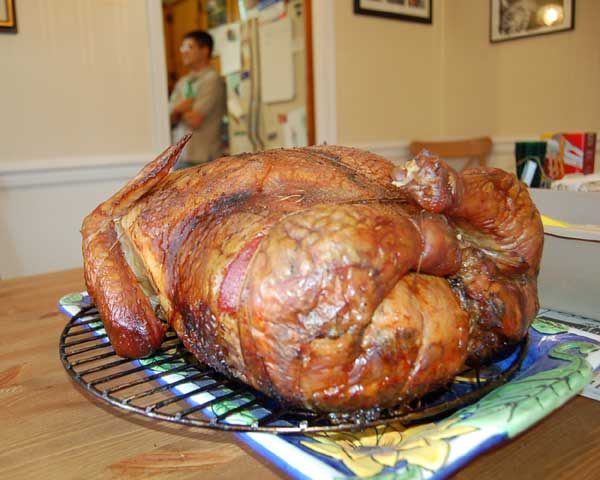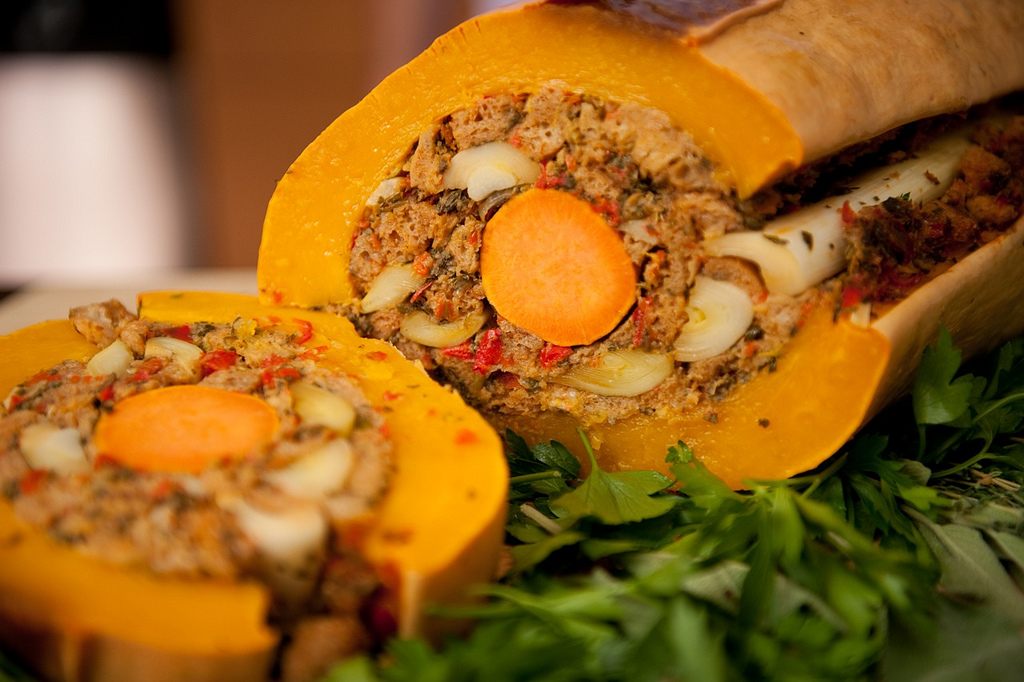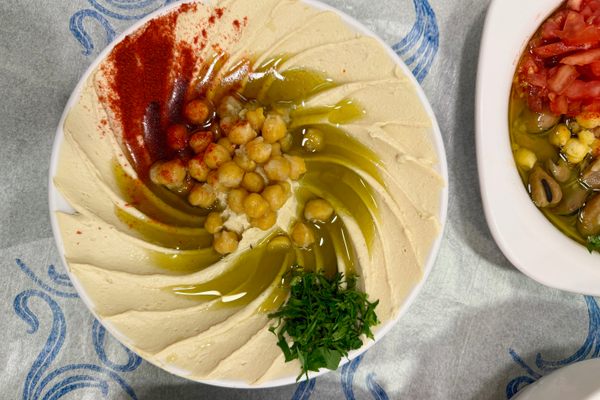How Turducken Went From Food Of Kings To Poultry of the Populace

Four and twenty blackbirds baked in a pie–the blue-blood ancestor of the turducken. (Image: Mother Goose’s Melodies/WikiCommons Public Domain)
Once upon a time, you had to be royalty to be surprised by your food. But these days, an ordinary Thanksgiving gathering is cause for trepidation and excitement. It’s 2015, and any turkey you face could be a turducken.
The turducken, if you’ve managed to avoid its company thus far, is exactly what it sounds like–a chicken stuffed into a duck stuffed into a turkey, all deboned and layered with various types of stuffing. It looks like a regular turkey, but, when cut, magically reveals its true soul (the duck), as well as its soul’s soul (the chicken). It would fit nicely next to a Midwestern dessert salad, but is also the kind of main course you’d expect from a Thanksgiving feast thrown by the psychedelic machine minds at Google Deep Dream. In short, it is a truly mysterious food, melding the nostalgic with the futuristic, the traditional with the impossible.
The carnivore-baiting chimera has been a gold-plated staple of New Orleans cuisine since 1980, when Chef Paul Prudhomme began serving up a Cajun-inflected version in his restaurant, K-Paul’s Louisiana Kitchen. Prudhomme trademarked the name in 1986, and we’ve been calling it that ever since.

Chef Paul Prudhomme, Father of the Turducken. (Photo: Brett Rosenbach/WikiCommons CC BY 2.0)
But although the branding may be new, the meatmanteau it describes is not. Roman emperors were said to enjoy the occasional “tetrafarmacum,” a concoction of sow’s udder, pheasant, wild boar, and ham, piled together in a starchy shell. Medieval lords would flaunt their prestige by commissioning complex “illusion foods”—huge pastry castles stuffed with meat and fruit, or roasted peacocks with the feathers carefully replaced, so that diners could have their ‘cock and eat it too. One 15th-century king was fond of cockentrice, a pig’s top half sewn onto a rooster’s bottom. The more specific vision of “putting one bird inside another bird inside of another bird and cooking them” goes back to the Renaissance, when it was practically common practice, says food historian Andrew F. Smith.
As meat became less of a luxury, everyday people got in on the game. By the 18th century, ordinary (though ambitious) British homemakers were encouraged to impress their guests with “Christmas Pyes” filled with three or four nested fowls. By the 19th century, Smith says, “there are many recipes in American cookbooks that talk about the same kind of concept,” often adding beef tongue, pork, and other meats to the fray.
After Prudhomme carved his version into the history books, the turducken became a regional favorite, a joyfully off-kilter food you could get in the joyfully off-kilter city of New Orleans. Nationwide popularity came a couple of decades later, courtesy of enthusiastic fan John Madden, who carved one on live TV during a Thanksgiving Day football game broadcast in 1997. After that, the turducken expanded its reach, slowly pulling in devotees from up north and out west. In 2010, it made the Oxford English Dictionary, and now you can buy a frozen one at Sam’s Club.

A properly cooked turducken looks like an overfed turkey. (Photo: Engelmann/WikiCommons CC BY-SA 3.0)
There are tons of strange, previously royal foods commoners wouldn’t dream of mass-producing. Why did the ungainly turducken make the leap? Smith thinks it was a question of etiquette and thrift. With a regular turkey, “you can only do so much with a knife and a fork,” he says, “and if you’re in polite company, on occasion, it can get a little awkward, or you waste a lot of meat.” The turducken, he says, sidesteps these problems–you get all of the meat with none of the mess. (Tell that to John Madden, who said of his first time: “It smelled and looked so good. I didn’t have any plates or silverware or anything, and I just started eating it with my hands.”)
J. Kenji Lopez-Alt of Serious Eats perfected his turducken recipe in 2012. But after years of obsessing over oven temperatures and stuffing composition, he thinks the appeal is skin-deep. Taste-wise, he says, a turducken is less than the sum of its birds. “It’s a stunt food,” he says. “People make it because it’s a feat of engineering. It’s just, ‘What thing can we stuff into another thing?’”

The veggieducken lets everyone get in on the game. (Photo: The Sporkful/Flickr)
Lopez-Alt attributes the canonization of this impulse to the internet, where “if someone does something ridiculous, somebody’s going to say, ‘Hey, look at this ridiculous thing.” Stuffing things into other things is the online stunt-food version of dressing to impress. “That’s how Taco Bell comes up with new menu items, right?” he asks.
A quick glance at the turducken internet reveals that the standard variety no longer suffices. The turducken arms race has escalated, leading to monstrosities like the 12-bird roast, the Lovecraftian Cthurkey, and the cherpumple, a dessert-course spinoff that has several different pies baked inside the layers of a cake.
This is only natural. In a world where ordinary people eat turducken, the true royals, internet or otherwise, have to separate themselves from the plebes. And the way to do that, as Lopez-Alt says, is to ”stick things in other things” in increasingly immoderate ways.
Gastro Obscura covers the world’s most wondrous food and drink.
Sign up for our email, delivered twice a week.
























Follow us on Twitter to get the latest on the world's hidden wonders.
Like us on Facebook to get the latest on the world's hidden wonders.
Follow us on Twitter Like us on Facebook